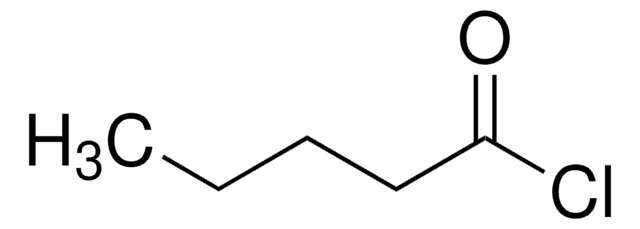Key Documents
156833
Nonanoyl chloride
96%
Synonim(y):
Pelargonyl chloride
About This Item
Polecane produkty
Poziom jakości
Próba
96%
Postać
liquid
współczynnik refrakcji
n20/D 1.438 (lit.)
tw
108-110 °C/22 mmHg (lit.)
gęstość
0.98 g/mL at 25 °C (lit.)
grupa funkcyjna
acyl chloride
ciąg SMILES
CCCCCCCCC(Cl)=O
InChI
1S/C9H17ClO/c1-2-3-4-5-6-7-8-9(10)11/h2-8H2,1H3
Klucz InChI
NTQYXUJLILNTFH-UHFFFAOYSA-N
Szukasz podobnych produktów? Odwiedź Przewodnik dotyczący porównywania produktów
Zastosowanie
- N-nonanoyl piperonylamide
- caged vanilloid, N-(4-hydroxy-3-methoxybenzyl)-N-(2-nitrobenzyl)-nonanoylamide or N-(2-Nitrobenzyl)-N-vanillyl-nonanoylamide
- n-benzylnonanamide
Inne uwagi
Hasło ostrzegawcze
Danger
Zwroty wskazujące rodzaj zagrożenia
Zwroty wskazujące środki ostrożności
Klasyfikacja zagrożeń
Eye Dam. 1 - Skin Corr. 1B - STOT SE 3
Organy docelowe
Respiratory system
Kod klasy składowania
8A - Combustible corrosive hazardous materials
Klasa zagrożenia wodnego (WGK)
WGK 3
Temperatura zapłonu (°F)
210.2 °F
Temperatura zapłonu (°C)
99 °C
Środki ochrony indywidualnej
Faceshields, Gloves, Goggles, type ABEK (EN14387) respirator filter
Wybierz jedną z najnowszych wersji:
Masz już ten produkt?
Dokumenty związane z niedawno zakupionymi produktami zostały zamieszczone w Bibliotece dokumentów.
Klienci oglądali również te produkty
Nasz zespół naukowców ma doświadczenie we wszystkich obszarach badań, w tym w naukach przyrodniczych, materiałoznawstwie, syntezie chemicznej, chromatografii, analityce i wielu innych dziedzinach.
Skontaktuj się z zespołem ds. pomocy technicznej













